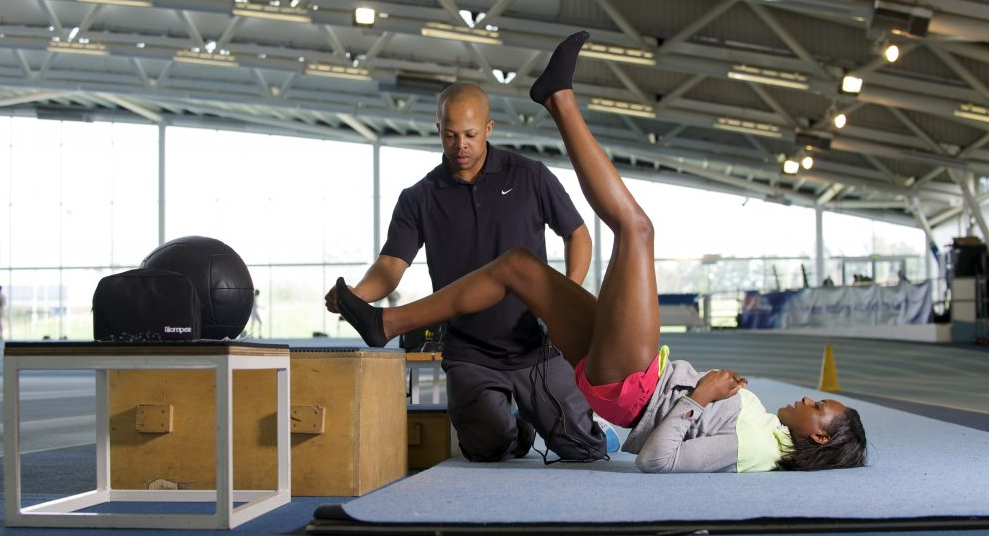Jonas Dodoo is the founder of Speedworks Training in London, where he and his team train, develop and prepare some of Great Britain’s top athletes. We talked with Jonas about the philosophy, culture and approach that underlies the success his athletes have had.
What were some of the training techniques and approaches that you learned from Dan Pfaff in the years before the London Summer Olympics that are more widely-accepted now?
Jonas Dodoo: What Dan brought to the UK was trackside therapy and a training blueprint that a number of coaches are using at the moment. We’re doing a far more therapy-based program for the athletes, and looking at biomechanics and acceleration first, rather than training for volume and training load.
What type of athletes succeed best in the environment that you and your team have created at Speedworks?
JD: There’s a certain type of athlete that suits our system: an athlete that wants to learn about their sport, experiment with movement patterns and be challenged to be better. If you want to do this the right way – avoiding doping as the only road to success – you have to work on biomechanics, plyometrics, nutrition, recovery, lifestyle. New athletes that have not come from that background are challenged because we challenge them to grow in every element of their life.
How are athletes approaching their training – particularly use of tech – differently now than earlier in your career, given that sports tech is now so much more established? Are coaches or athletes more resistant?
JD: All things are about improvement. If the athlete can see and visualize from data that they are progressing and working towards KPI’s they will accept [that technology and the data]. It has to be digestible. Make it clear and concise. You can not just focus on x’s and o’s. You have to equally focus on fluidity of movement and subconscious flow.
It’s the balance between educating with numbers and teaching movement.
So “new school” vs. “old school” is a false dilemma?
JD: Old schools ways are the same ways. They’re just a different way.
Sprinting is simple. The equation is simple. Depending on the athlete and his or her gifts, you may have a stride length or stride rate dominant run. But the event is the event. We know the stress it puts on the body and we know how it takes its toll.
Look @themotionclinic @rawathleticism @LeahDunthorne you've all built a winner! Well done guys! @speed_works_ https://t.co/3odSu9w7wZ
— Jonas Dodoo (@EatSleepTrain_) July 1, 2017
The needs analysis is quite clear. Technology should just tell us how well we’re doing what we’re doing. It should tell us accurately what we need, and help us analyze and synthesize the output. Tech should just be helping us figure these things out at quicker rate. We cannot allow it to confuse us, misguide us or distract us.
How do you approach new athletes and integrate their background and training history into your system?
It’s a transition process for both coach and athlete, and it takes time for the coach to know both the athletes and the system.
You have to listen to your athletes. If you know they’ve done things for peaking and to know when they are in shape, they have the memory and emotions around when they are running fast and how their body feels. That is really important information.
If they tell you this early on you have to understand it, break it down and give it to them systematically over time. Coaches can become emotionally attached to the programs they write for their athletes, rather than the programs their athlete needs. Take an ego step away.
On the other side, how do new athletes take to your system? Are they taken aback by the attention to movement detail if they have perhaps come from a volume-intensive program?
Athletes that come from a training load program with high volume are probably shocked by the intensity of training early in the year. Newer athletes probably find it easier because it’s a blank canvas and we ease them into the program.
Great work from our intern @stevebows89, in the gym prior to a running session with one of the athletes. https://t.co/GJUNqiTNel
— Speedworks Training (@speed_works_) July 1, 2017
Volume does work. Overload does work, but only so much. The stimulus has to keep evolving and changing. If you want to stay healthy on the process you need to move well, to spring well. An important part of my early learning was that not everyone takes to a minimum dose program. You have to explore what they need to bring their gifts to bloom.
How do you stay up on the latest research, ideas, technology and trends?
I network. I know geeks and I’m a geek. I know biomech geeks, geek physios, geek osteos, geek S&C coaches. I know geeks who are not just involved in HP sport, but are well-read but are also not naive so they’ll read things and filter them. They keep me grounded.
[av_button_big label=’Resisted and assisted sprinting for post-activation potentiation with 1080 Sprint’ description_pos=’below’ link=’manually,http://1080motion.com/assisted-sprinting-post-activation-potentiation/’ link_target=” icon_select=’no’ icon=’ue800′ font=’entypo-fontello’ custom_font=’#ffffff’ color=’theme-color’ custom_bg=’#444444′ color_hover=’theme-color-subtle’ custom_bg_hover=’#444444′ av_uid=’av-37vyl5′][/av_button_big]
I synthesize my program by listening to others and understanding others.






























































